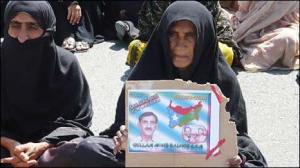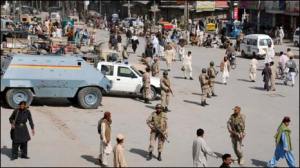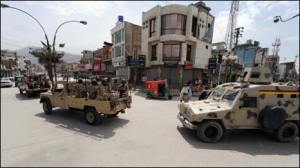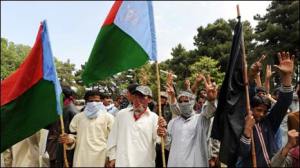Shaheryar Ali
Some Theoretical Considerations: Death of Pluralism
“The article is intended to be the theoretical first part of a series of article on the suppressed cultural identities[A Pakistan you never knew] in Islamic Republic of Pakistan, One on the fate of Pakistani Jews has already been published and can be reached here”
A couple of years back I was reading a research report by a very intelligent Pakistani academic who works for the International Crisis Group, Dr Samina Ahmed on the rise of sectarianism in Pakistan. Being trained in the progressive tradition myself I was familiar with the theoretical framework in which Dr Ahmed operates, state and its origin, adaptation of an ideological character by the state, cold war and Jihad etc. What strike me and infact fascinated me was a passing remark by her on working ideology of all sectarian groups of Pakistan, she wrote they all operated on the “principle of exclusion”
This was a remarkable observation if one wants to understand the ideology of sectarianism and a sectarian state. States are not just material institutions of economy and violence, state has an ideological aspect as well. Structures of the state create a significant influence on super structures of the society on which it is maintaining control. That means through different ideological institutions, states create culture and patterns of thoughts which help the state to keep control [Gramsci and Althusser]. It has been explained as a mental condition in which a slave thinks and takes his slavery to be a state of “freedom”. This intervention into ideology or the “ways of thinking” became the obsession of western Marxists who were trying to understand failure of revolutions in the Western Europe. A series of whole new disciplines emerged like critical theory and cultural studies which focused on the ideological and cultural aspects of state and/or capitalism
As postmodernism became more influential in universities of Europe and North America, the critique was extended to a similar analysis of “reality” [Baudrillard] and alterations in human perceptions by Capitalism and state/super state. The ideological foundations of Pakistan state [not to be confused with official “Pakistan ideology”] lie in the communal/nationalist strife [Saigol,Rubina] which presumed an “absolute difference” between Hindus and Muslims. Jinnah put forward an argument which utilized “cultural difference” as base of civilization, which differentiated Indian Muslim from Indian Hindus with whom he shared same ethnicity and language [Bengali speaking muslim became part of a different civilization and nation than Bengali speaking Hindu from whom he originated in the first place through conversion]. Hindu and Muslim emerged as grand identities which were rhetorical in entity as demonstrated by the work of great Indian historian Romila Thaper, that before British Colonialism term Hindu or Muslim were rather meaningless in the sense that they didn’t constructed a unified socio-political identity. With the professed anti-clericalism and modernism of founding fathers of Pakistan, ideological intervention became all the more important and a unified cultural umbrella needed to be constructed to legitimize the claim of “distinct civilization”. This logically meant to suppress the ethnic, national and indigenous identities to construct the “Muslim identity” only through which survival of Pakistan was envisioned.
 A study of discourse emerging from ruling elite of Pakistan, the PML and colonial administration which they inherited from Colonial administration suggest an obsession with monism themes as opposed to pluralism. Jinnah’s slogan of “Unity, Faith and Discipline” itself speaks of need to “unify and control”. The slogan relates more to ideologies of totalitarian regimes of Stalinist Russia and Nazi Germany than to the Liberal tradition of Western Europe to which Jinnah is said to be trained in. Ethnic identities became the “others” of Muslim identity and as a result an existential threat the new state. The question of national rights was diverted by Jinnah’s stern warning against the “evil of provincialism”, the need to construct a “unified culture” so strong that a man as modern as Jinnah who took up the case of muslim socio-cultural rights in India, stood in Dacca and thundered “Urdu Urdu and only Urdu!” a language which was not the language of even 0.2% of Pakistanis at the time Those who demanded an equal status of Bengali along side Urdu were to called traitors and communists. After Jinnah’s death things became worse and PML which lacked any popular base in East and West Pakistan joined hands with Clerics and Islamic Fundamentalists whom Jinnah thoroughly despised. Jinnah’s handpicked Prime Minister Nawabzada Khan Liaqat Ali Khan, a member of feudal aristocracy passed the Objectives Resolution and state acquired an ideological character.
A study of discourse emerging from ruling elite of Pakistan, the PML and colonial administration which they inherited from Colonial administration suggest an obsession with monism themes as opposed to pluralism. Jinnah’s slogan of “Unity, Faith and Discipline” itself speaks of need to “unify and control”. The slogan relates more to ideologies of totalitarian regimes of Stalinist Russia and Nazi Germany than to the Liberal tradition of Western Europe to which Jinnah is said to be trained in. Ethnic identities became the “others” of Muslim identity and as a result an existential threat the new state. The question of national rights was diverted by Jinnah’s stern warning against the “evil of provincialism”, the need to construct a “unified culture” so strong that a man as modern as Jinnah who took up the case of muslim socio-cultural rights in India, stood in Dacca and thundered “Urdu Urdu and only Urdu!” a language which was not the language of even 0.2% of Pakistanis at the time Those who demanded an equal status of Bengali along side Urdu were to called traitors and communists. After Jinnah’s death things became worse and PML which lacked any popular base in East and West Pakistan joined hands with Clerics and Islamic Fundamentalists whom Jinnah thoroughly despised. Jinnah’s handpicked Prime Minister Nawabzada Khan Liaqat Ali Khan, a member of feudal aristocracy passed the Objectives Resolution and state acquired an ideological character.
The ideological apparatuses of the state in form of media, mosques,

Nawab Bahadur Yar Jung
universities and colleges started molding the minds of people. Considering one to be a Bengali or Punjabi was something like treason, same was the case with being Muslim. In British India Muslim was a broader and loose cultural identity which related more to practice of circumcision and burial of dead as opposed to cremation. Different sects of muslims existed and considered their sect to be true version of Islam but due to neutrality of the state didn’t operated on the “principle of exclusion”. The party which took up the issues of muslim socio-political and cultural rights in British India, the All India Muslim League comprised of “muslims” which were distinguishable by their heterodoxy not their orthodoxy. Sir Aga Khan was the president of All India Muslim League who was the Imam of Ismilies which were engaged in a bloody struggle against Sunni and Twelver Shias for more than 1000 years and who were considered “apostates” by clerics of both mainstream sects. Muhammed Ali Jinnah also belong to the Ismaili faith but later converted to more mainstream Twelver Shia faith but was a non practicing muslim by all standards. Many important leaders like Raja Sahib of Mehmoodabad were twelver Shias. Sir Zaferullah Khan was Ahmedi or Qadiani. Dr Allama Muhammed Iqbal was a revivalist who was opposed by Sunni orthodoxy and was rumored to be a Ahmedi as well the controversy ended when he denied these claims by writing an article in Statesmen condemning Ahmedi faith. [Controversy still exist weather he was Ahemdi for some part of his life and even after condemning Qadiani faith he considered Lahori group of this faith as part of muslim community]
Nawab Bahaduryar Jang another prominent leader of All India Muslim League belonged to “Mehdivia” sect. a sect similar to Ahmedies which considered pious saint Syed Muhammed Jonpuri as the Mehdi. Due to this heterodoxy and professed modernism of All India Muslim League the muslim clerics were bitterly against it. But this was to be changed when this movement was to end in formation of the “Muslim Homeland” [Not an intention of Jinnah according to some historians, most notably Dr Ayesha Jalal]. With the formation of Muslim homeland the question “Who is Muslim?” acquired a phenomenal character. Before partition as we have said earlier this question was not very relevant because of its oppositional character to the rival identity “The Hindu”. After partition of India on 15th August 1947 all this changed. Muslim identity lost its contrasting “other”, a “moth eaten Pakistan” meant that its founding fathers were already paranoid about its chances of survival; the land which they got was hub of forces which opposed partition of India. Punjab was firmly in grip of feudal, with which Jinnah forged an alliance to make Pakistan, the Unionist Party held power in Punjab. All India Muslim League lacked support and organization in Punjab, the “salariat” class which was motivating the struggle for Pakistan was weakest in Punjab [Alavi,Hamza]. NWFP the province of overwhelming muslim majority despite best efforts of Jinnah stood with Bacha Khan and Indian National Congress. The 1946 elections which were held to decide the issue of muslim representation saw defeat of Muslim League despite support from the British in the NWFP. In Bengal muslim league held popular base but it was due to independent minded progressive leaders whom the central leadership didn’t trusted, Hussein Shaheed Soherwardi, AK Fazel-e-Haq, Molana Bhashani all were to be purged along with all mass base! Jinnah had to lean heavily on “socialism”[He went as far as declaring Islamic Socialism to be guiding ideology of Pakistan in Chittagong] to gain currency in Benagal but his negotiations with the Americans in 1946 had already decided Pakistan’s future alignment with “Anti-socialist block”. Bengali was suppressed, NWFP government dismissed, the party banned and its news paper “Pakhtoon” suppressed [start of press censorship in Pakistan, all this happened in first year of Pakistan]. The party headquarter was bulldozed and police opened fired on unarmed party workers at Barbra killing hundreds of Pushtoons, this despite Bacha Khan’s oath of loyalty to Pakistan. In Sindh , GM Syed had already left Muslim League depriving it of much popularity, the loyal faction of Sindh League was also disenfranchised when Jinnah dismissed Sindh government as well when CM opposed partition of Sindh [separating Karachi from Sindh] This would be the start of never ending Sindhi-Mohajir conflict. Balochistan had to be annexed by force when upper and lower houses of Parliament of State of Qalat explicitly rejected proposals to join Pakistan. Khan of Qalat signed the document of accession but wrote himself that he didn’t have the authority to do so.
All these events which took place in first years or couple of years after birth of Pakistan unfortunately counterpoised “Muslim identity” against the local identities which also represented political opposition to Pakistan’s ruling elite. It became a rule to suppress any expression of cultural identity other than the official “Muslim” one. This was to be what I call “death of Pluralism” in Pakistan. After deciding the fate of national identities, the project of defining “muslim” came on agenda. Death of Jinnah accelerated the process and state’s alliance with fascist theorist Abul ala Maudaudi emerged. He gave a series of lectures on Radio Pakistan on Muslim Nationalism. Objectives resolution was passed, later Anti Ahmedi agitation started, the anti clerical vanguard in state tried to give a final resistance to the clerics. Justice Munir’s report tried to put clerics at their place but it was too late. A unified and oppressive muslim identity emerged which put all heretical muslim sects in a continuous state of fear of being declared “apostates”. The irony of history is that with this most of the founding fathers of this country also joined the ranks of “apostates” All alternative cultural expression vanished from the country, the Hindus, the Jews, Homosexuals, Heretics, Nationalists all had to face “cultural Holocaust” After Ahmedies Shias were targeted and now Bravelies are trying to protect their “islam” from muslims

Sir Zafrullah Khan

 A call for Wheel Jam strike was given by Balochistan National Party [M] and Baloch National Front. According to BBC the wheel jam strike was a success. Surprising development which took place that Pashtun base Islamic fundamentalist Party of Molana Fazul-ur-Rehman supported the call of wheel jam strike. This party is considered traditional ally of establishment in Balochistan. What was disturbing that Pashtun Nationalist Party PKMAP of Mehmood Khan Achackzai which were part of NAP and traditional allies of Baloch nationalists were no where to be seen.
A call for Wheel Jam strike was given by Balochistan National Party [M] and Baloch National Front. According to BBC the wheel jam strike was a success. Surprising development which took place that Pashtun base Islamic fundamentalist Party of Molana Fazul-ur-Rehman supported the call of wheel jam strike. This party is considered traditional ally of establishment in Balochistan. What was disturbing that Pashtun Nationalist Party PKMAP of Mehmood Khan Achackzai which were part of NAP and traditional allies of Baloch nationalists were no where to be seen.


 Killing of witnesses threatens the possibility of any justice regarding the large numbers of persons who have disappeared in Pakistan. These recent killings seem to indicate the mobilisation of secret units in order to eliminate those who have knowledge about the maintenance of secret prisons and torture chambers in the country. Particularly those who have taken a keen interest in pursuing justice relating to these matters have been made targets of these killings. It is likely that these killings will be followed by similar actions to others. The knowledge about these murders will also discourage victims and witnesses who want to narrate the human rights abuses they have suffered and to seek justice. The deadening silence imposed in such circumstances will obstruct all attempts to return to a normal situation of rule of law. Now with the intervention of the Supreme Court under the Chief Justice, Iftekhar Choudhry who has been reinstated by popular intervention. On the other hand the terror tactics adopted in this way will act to the advantage of the extremist elements who resort to terrorism
Killing of witnesses threatens the possibility of any justice regarding the large numbers of persons who have disappeared in Pakistan. These recent killings seem to indicate the mobilisation of secret units in order to eliminate those who have knowledge about the maintenance of secret prisons and torture chambers in the country. Particularly those who have taken a keen interest in pursuing justice relating to these matters have been made targets of these killings. It is likely that these killings will be followed by similar actions to others. The knowledge about these murders will also discourage victims and witnesses who want to narrate the human rights abuses they have suffered and to seek justice. The deadening silence imposed in such circumstances will obstruct all attempts to return to a normal situation of rule of law. Now with the intervention of the Supreme Court under the Chief Justice, Iftekhar Choudhry who has been reinstated by popular intervention. On the other hand the terror tactics adopted in this way will act to the advantage of the extremist elements who resort to terrorism











